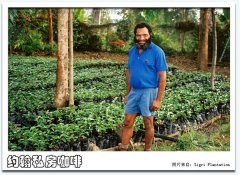Coffee processing Coffee beans processing
1. Peeling
Remove the peel and most of the pulp mechanically or manually.
two。 Ferment
By removing the mucus and film outside the core by fermentation, each manufacturer has its own fermentation time because the length of fermentation time will affect the flavor of coffee.
3. Drying
The drying method is mainly divided into natural sun drying and natural air drying. Too high water content is easy to cause coffee raw bean mildew and insect growth, too high water content will also cause high acidity of coffee.
4. Baking
Through roasting, raw coffee beans can release the special aroma of coffee. Each coffee bean contains its fragrance, sour taste, sweetness and bitterness. How to release it incisively and vividly is to observe the heat of its baking, from the insipid raw beans to the endless fragrance in the cup. Roasting is a very important step in the long journey of each coffee bean.
Coffee beans are about 10 or 20 minutes long (inversely proportional to the temperature) and the temperature is as high as more than 200 degrees Celsius. In the process of dialogue with the hot dish, coffee beans undergo many chemical changes, giving off a first explosion, a second explosion, a sound like popcorn, and loss of moisture. From raw beans, light roasting, medium roasting to deep roasting, the water is released again and again, the weight is reduced, but the volume slowly expands, the color of the coffee beans deepens, the fragrant oil is gradually released, and the texture becomes crisp. In raw beans, there is a lot of chloric acid, which gradually disappears with the baking process, releasing familiar and pleasant fruit acids, such as acetic acid, citric acid and malic acid in wine. Baking properly presents these beautiful sour taste in moderation.
Light baking-when the beans make the first light sound, the volume expands at the same time, and the color changes to a delicious cinnamon color. Acidity dominates the flavor of shallow roasted beans, texture and taste have not been brought into full play, generally used as canned coffee.
Medium roasted-coffee beans show an elegant brown color. This method of baking is also called City roast. Medium roasting can not only preserve the original flavor of coffee beans, but also moderately release aroma, so the blue mountains of Jamaica, Colombia, Brazil and other individual coffee, more choose this roasting method. At 20 minutes, the oil begins to surface, and the beans are burned into an oily dark brown, called full-city roast, when the sour, sweet and bitter taste of coffee reaches the perfect balance, and the character of coffee beans is clearly depicted.
Deep roasting-the darker the color of the coffee beans, the sweeter the flavor, when the oil has turned into caramel, bitter back to sweet, endless aftertaste, the most suitable for the strong Italian Espresso, so it is also called Italian baking. Moderate roasting gives life to the coffee beans and turns them into intriguing sweetness and bitterness. People who are sensitive to caffeine might as well choose deep-roasted beans, because in the process of deep-roasting, caffeine will slowly escape, so the deeper the roasted beans, the lower the caffeine content, the caffeine content in a cup of Espresso is only half that of other medium-roasted coffee, the general Espresso coffee capacity is less, if equal to the general coffee capacity, the caffeine content is much higher.
Important Notice :
前街咖啡 FrontStreet Coffee has moved to new addredd:
FrontStreet Coffee Address: 315,Donghua East Road,GuangZhou
Tel:020 38364473
- Prev

Hand-selected coffee beans and defective coffee beans
I agree that apples don't taste different because of their size, but when it comes to roasting coffee beans, they all have to be heated anyway, and it doesn't matter if the coffee beans are different in size. Coffee beans harvested from the same tree, regardless of size
- Next

Primary processing of coffee washed coffee in Sigri farm
Having nothing to do, I was looking for some information about Sigri farm coffee in Papua New Guinea. I found these photos and information on the Gimmetries Coffee website. Sigri Plantation is located in the Papua New Guinea highlands. Growing conditions here are well-suited for coffee: about 5200 feet above
Related
- Guji coffee producing area of Guji, Ethiopia: Humbela, Shakiso, Wulaga
- What is the most expensive variety of Qiloso in BOP multi-variety group?
- How to store the coffee beans bought home?
- Why are Yemeni coffee beans so rare now?
- Ethiopian Sidamo all Red Fruit Sun Sun Santa Vini Coffee beans
- SOE is mostly sour? What does it mean? Is it a single bean? what's the difference between it and Italian blending?
- Is Italian coffee beans suitable for making hand-brewed coffee?
- How to choose coffee beans when making cold coffee? What kind of coffee beans are suitable for making cold coffee?
- Just entered the pit to make coffee, what kind of coffee beans should be chosen?
- Can only Japan buy real Blue Mountain Coffee? What are authentic Jamaican Blue Mountain coffee beans?

